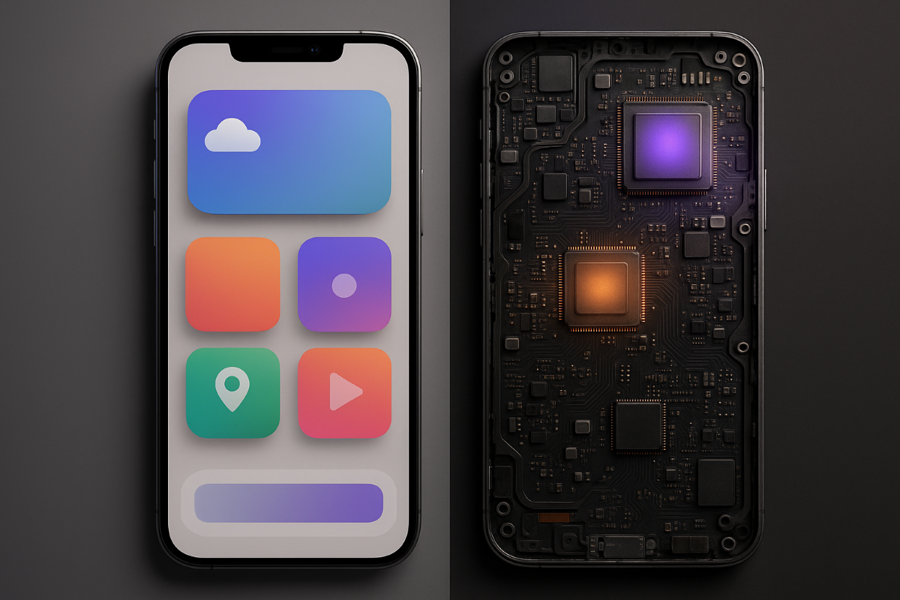
When planning a new digital project, whether it’s building a bespoke app or business application, or automating workflows, the technology stack you choose is one of the most important decisions you’ll make.
For CTOs, Digital Leads, and IT Managers, it’s not about picking the trendiest framework. It’s about ensuring your apps and software are secure, scalable, and built to deliver long-term business value.
The basics: Front-End vs. Back-End
- Front-End (Client-side): This is what users interact with—the interface and experience of your web or mobile app. Frameworks like React, Angular, or Vue help create fast, responsive, user-friendly journeys.
- Back-End (Server-side): This powers the app behind the scenes—managing data, integrations, and security. Technologies like .NET, Node.js, or Python, paired with databases such as SQL Server or PostgreSQL, make sure your solutions are reliable and efficient.
Together, front-end and back-end form the core of any successful app or software solution, brought to life by the business logic, integrations, and hosting infrastructure that sit around them.
What matters before you build
Before deciding on frameworks or tools, step back and consider what matters most to your organisation:
1. Performance and scalability
Whether it’s a customer-facing app or an internal system, poor uptime or lagging performance will lose users fast. Cloud-native infrastructure, load balancing, and optimised code are critical for scalability as demand grows.
For example, when we partnered with a global energy efficiency solutions provider, moving engineers from paper-based processes to a bespoke app reduced data entry time, improved scalability, and delivered a seamless offline experience—showing how the right back-end foundation can transform efficiency.
2. Security and compliance
For apps handling sensitive or financial data, compliance with ISO, PCI-DSS, or WCAG standards is non-negotiable. Automated monitoring, secure cloud hosting, and proactive patching should be part of your stack from day one.
3. Integration and automation
Disconnected legacy systems make apps harder to use and maintain. Modern stacks should enable:
- APIs and integrations to connect existing business systems.
- AI and automation to reduce manual tasks and reporting.
- Data migration to bring information cleanly into new apps and software.
This is where we often see the biggest wins: automating repetitive reporting tasks or connecting siloed platforms can save organisations hundreds of hours a year.
4. Internal capacity
Not every organisation has the in-house skills to build and evolve complex applications. Partner models, such as managed services or our Dev in a Box services, allow you to scale development capacity and ongoing app support without overloading your internal team.
If your roadmap is ambitious but your development capacity is stretched, tapping into flexible expertise can help keep projects moving without the overhead of permanent hires.
5. Future-proofing
Don’t just build for today. Whether through rapid prototyping to validate app ideas quickly, adopting bespoke solutions tailored to your workflows, or embedding AI-driven automation into your applications, your stack should evolve as your organisation grows.
Balancing Front-End and Back-End
So which is more important?
The truth: neither layer can succeed without the other.
- A beautifully designed front-end app will fail if the back-end can’t scale.
- A powerful back-end is wasted if the front-end doesn’t deliver a smooth experience.
- Without strong integration across both, you’ll end up with manual workarounds instead of streamlined apps.
The real power comes when your apps, business applications, and software solutions are designed holistically—with the front-end and back-end working seamlessly together.
Key takeaway
When defining your tech stack, don’t get caught up in hype. Focus on the fundamentals:
- Will this deliver secure, scalable apps and business applications?
- Does it integrate with your ecosystem and reduce manual workload?
- Can it grow with you—supported by flexible development capacity and ongoing managed services?
By asking these questions upfront, you’ll ensure your front-end and back-end choices become enablers of progress—helping you design and build apps and software solutions engineered for growth.
At Digital Wonderlab, we help organisations do exactly that—through discovery and prototyping, bespoke app development, AI & automation, and ongoing managed services. The result? Digital solutions that are designed for people, and engineered for growth.






